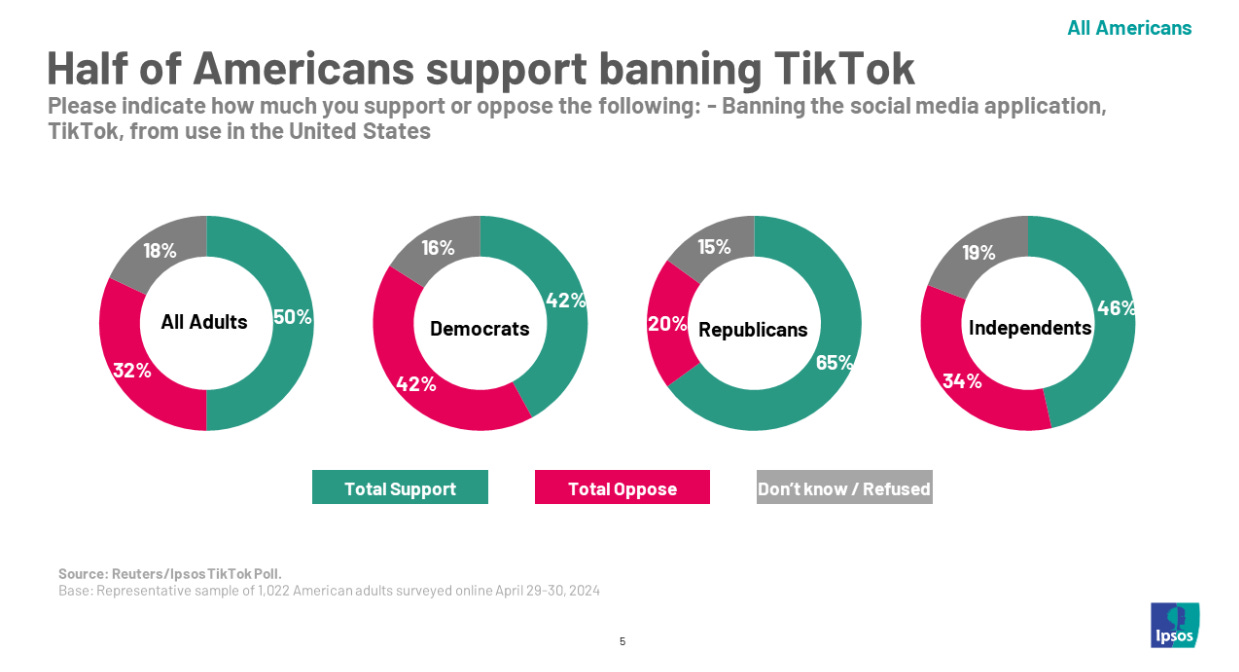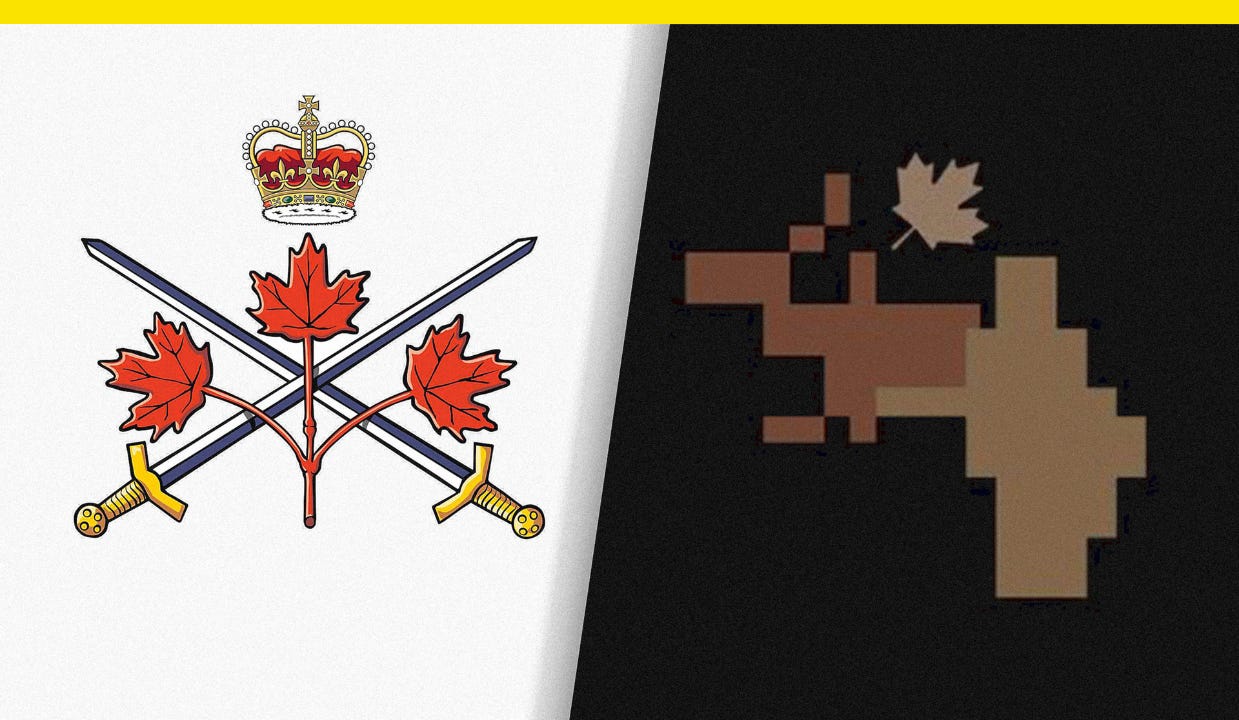Why this state Democratic Party is using a panther for its mascot instead of a donkey
Plus: Trump is reportedly considering joining TikTok. Here’s why that may be tricky for him.
Hello, in this issue we’ll look at…
Trump is reportedly considering joining TikTok. Here’s why that may be tricky for him.
Why this state Democratic Party is using a panther for its mascot instead of a donkey
The Canadian Army misfires with secondary camo logo
Scroll to the end to see: why Coke trashed its logo for a good cause 🥤
Trump is reportedly considering joining TikTok. Here’s why that may be tricky for him.
Who’s ready for TrumpTok?
Former President Donald Trump — who posts across fewer social networks than President Joe Biden — is reportedly considering joining TikTok. The Trump campaign is discussing whether the benefits of joining outweigh criticism he might face for being one of the few high-profile Republicans on the app, according to the Washington Post, and one advisor hoped his joining would create a sense that “being pro-Trump had become a counterculture movement, and … that it is the cool, edgy thing to be Trump-adjacent.”
Though Biden signed a bill into law last month that would ban TikTok unless it was sold, it wouldn’t go into effect until after the election, forcing campaign comms teams everywhere to decide what to do with the app.
Trump has been too busy in court to really consider whether or not to join, advisors said (on Tuesday, Stormy Daniels testified in graphic detail about their brief alleged sexual encounter and a payment and she said she received years later to keep it quiet after leaked “Access Hollywood” footage included audio of Trump boasting about grabbing women without their consent because he was famous). But advisors believe “Trump’s punchy quips” are “well-calibrated for virality on TikTok,” per the Post. They have a point.
Before Trump was known for his Twitter account, he posted on Vine, Twitter’s short-lived short form video app. In 2013, Trump spoke there about Mac Miller name dropping him in a song, Bangerz-era Miley Cyrus (“Miley don’t let them get you down, they’re all jealous”), and a lot about Anthony Weiner. Trump wouldn’t need to learn any dance moves to make a splash on TikTok (they do the Dougie there, yeah?), he could just talk s***.
A recent Reuters-Ipsos poll, however, shows why Trump may hesitate to join. Half of U.S. adults support banning the app, compared to 32% opposed and 18% who were unsure, but the figure is even higher for Republicans, 65% of whom support banning it. That’s higher than independents (46%) and Democrats (42%). When Trump’s former Vice President Mike Pence’s advocacy group aired ads calling for a Senate vote on the TikTok bill last month, it wasn’t to convince Republicans, it was to provide air cover to vulnerable Democrats.
TikTok and its parent company ByteDance filed suit Tuesday accusing the law forcing a ban or sale of being unconstitutional.
“For the first time in history, Congress has enacted a law that subjects a single, named speech platform to a permanent, nationwide ban,” attorneys for TikTok wrote.
Why this state Democratic Party is using a panther for its mascot instead of a donkey
Florida always does things a little differently, and the state’s Democratic Party is no exception.
The party just announced its ditching the donkey, a longtime party symbol, for something a little closer to home, as it attempts to claw back votes this election year. A panther.
The official state animal, the Florida panther was once on the verge of extinction. But it’s seen a resurgence: their population has grown from about two dozen to more than 200 as of 2021. Now, Florida Democrats are hoping for similar growth after seeing their own numbers fall.
Florida Democrats have lost their footing in a state once considered a battleground. The state helped pick every president for 20 years, from Bill Clinton in 1996 to Donald Trump in 2016, but recently, it’s gone from purple to red. Democrats lost their 2020 voter registration advantage, and are now outnumbered by about 1 million registered Republicans, data from the Florida Department of State shows. Gov. Ron DeSantis won his reelection by a larger margin in 2022 than he did in 2018. Republicans have supermajorities in both chambers of the state legislature. Safe to say it hasn’t been looking ideal for Dems.
The new logo is part of an effort to rebrand the Florida Democratic Party from a party in retreat to one gaining ground in an important election year. “Florida panthers are fierce, and they’re making a comeback,” says Florida Democratic Party communications director Eden Giagnorio of the concept.
The possibility of a comeback is also due to Republican policy positions on abortion, LGBTQ+ issues, and TikTok, that according to Giagnorio, could make them vulnerable and put Florida back in play as a battleground state. Within this context, the panther logo emphasizes that the Democratic party will “fight for the issues that voters care about,” she says.
The Florida Democratic Party rebranded last year, going from a light-blue-and-white logo to one that was red, white, and blue to “reclaim elements of the flag, reclaim patriotism, reclaim freedom,” Giagnorio says. They fine tuned the brand and replaced the donkey symbol with a panther this year because they “wanted something that represented a more aggressive image of the Florida Democratic Party,” she adds.
Republicans are brushing it off. Chris Hartline, an advisor for Sen. Rick Scott’s (R-Fla.) reelection campaign, said Florida Democrats have “spent more time, energy and effort on redesigning their logo than they have on registering voters for the last ten years.” Evan Power, chairman of the Florida Republican Party, posted a graphic (below) detailing his interpretation of the new logo. (According to the graphic, the growling panther indicates “rage after losing all statewide elections.” The graphic also draws a parallel between the panther and state Democrats as an endangered species.)
In a text, Giagnorio said the Florida Democratic Party’s official response to Power’s diagram analysis was the meme of Charlie Kelly from It’s Always Sunny in Philadelphia explaining a conspiracy theory.
Polls show both Trump and Scott in the lead, but Democrats have made investments in the state, including 12 visits from Vice President Kamala Harris since she took office.
The donkey goes back to the first Democratic president, Andrew Jackson, in 1828, but it was cartoonist Thomas Nast who helped popularize both the donkey and Republican elephant as party symbols in the 1870s. Despite its long history, Florida Democratic Party chairwoman Nikki Fried doesn’t seem nostalgic for the longtime symbol.
“We gave the donkey the boot,” Fried wrote on X. “It’s time to kick ass in Florida.”
The Canadian Army misfires with secondary camo logo
Canada’s Army introduced a secondary logo that has people asking “How much did you pay for this?”
The logo is a detail from the Canadian Army’s new “Canadian disruptive pattern multi-terrain camouflage” in brown with a brown Canadian maple leaf. Online, people said it looked like a Lego moose or something from the video game Minecraft after the Canadian Army’s X account asked followers what they thought.
“I think it looks like the Army is saying it doesn’t know how to play Tetris,” wrote Goldie Chamari, a member of Ontario’s legislature.
In response to the blowback, the Canadian Army reassured followers it wasn’t dumping its longtime official logo, which shows three maple leaves connected at the stem in front of crossed swords under a royal crown.
“The Canadian Army has not changed its official logo,” the agency wrote on X. “The icon launched today is a supplementary design only that will be used in the bottom left corner of certain communications products and in animations for videos.”
The new mark, along with the camouflage pattern and the tagline “Strong. Proud. Ready.” (or “Forts. Fiers. Prêts.” for our friends in Quebec) comes as the Canadian Army faces what Bill Blair, the country’s defense minister, described as a recruiting “death spiral.”
“Over the past three years, more people have left than have entered,” Blair told a conference in March. “We cannot afford to continue at that pace. We’ve got to do something differently.”
Something different includes a brand refresh. As in the U.S., Canadian military branches use heraldic-style marks for their armed forces. While these symbols are imbued with heritage and tradition—and as misunderstandings about the supplementary Canadian Army mark show, getting rid of them would not go over well—designers find that speaking to a new generation requires branding that looks more Call of Duty than coat of arms.

In the U.S., which is facing its own military recruitment struggles, military branches have introduced more contemporary secondary logos to complement their old-school official emblems.
The Army, for example, uses a seal showing an eagle holding arrows and olive branches in its talons, but it also has a contemporary star logo and wordmark that spells out “U.S. Army” in a custom sans-serif font. The brand was refreshed last year for a new “Be All You Can Be” recruiting campaign that Major General Alex Fink, chief of Army enterprise marketing, said was designed to reach young people.
“We know youth seek purpose, passion, community, and connection, but we also know many don’t recognize the Army’s ability to deliver on those needs,” Fink said in a statement. “We need a brand that effectively communicates the possibilities of Army service.”
The initial response to the Canadian Army’s secondary logo suggests it might not be as effective as that of its neighbors to the south, but according to Alex Tétreault, Department of National Defense senior communications adviser, at least the new mark didn’t come at the Canadian taxpayers’ expense.
“The icon was developed without additional funds or involvement of external companies,” Tétreault told Canada’s public broadcaster CBC. “It was developed by DND’s internal graphic design team, and this icon comes at zero expense to the taxpayer.”
Have you seen this?
Critic says Noem’s workforce ad campaign should be “as dead as Cricket” after dog scandal, but state official says there are “no plans to make any changes.” “We currently have no plans to make any changes to ‘Freedom Works Here,’” said a spokesperson for the Governor’s Office of Economic Development. [South Dakota Searchlight]
Brad Parscale helped Trump win in 2016 using Facebook ads. Now he’s back, and an A.I. evangelist. Parscale says his company Campaign Nucleus can use A.I. to help generate customized emails, parse oceans of data to gauge voter sentiment and find persuadable voters, then amplify the social media posts of “anti-woke” influencers. [Associated Press]
Coke’s logo is iconic. The brand just demolished it in a new ad. Brand guides warn against stretching or otherwise manipulating a logo’s shape, but for a new campaign to encourage recycling in Latin America called “Recycle Me,” Coke crunched its logo like one of its cans. [Fast Company]
How does this Army psyop recruiting video make you feel? The U.S. Army’s psychological warfare unit is recruiting new members with a video that will make you go WTF. [Yello]
History of political design
Clinton-Gore button (1996). This button used images of hands signing the last names of the Democrats’ 1996 ticket in American Sign Language.
Portions of this newsletter was first published in Fast Company.
Like what you see? Subscribe for more:











